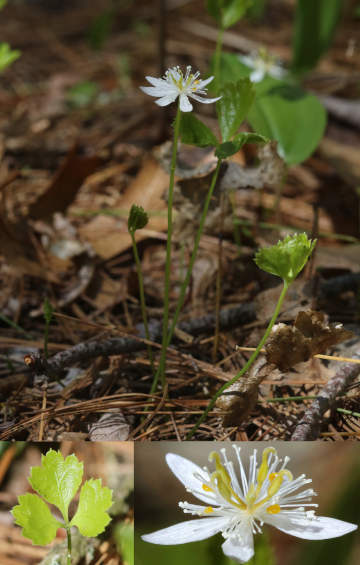Village News

PHOTO COURTESY OF GARRY KESSLER
Goldthread appears as small white blossoms in the spring. Photo courtesy of Garry Kessler
April 23, 2021, Page 9A
NATURE NOTES
By Annie Reid
Westborough Community Land Trust
Golden threads along the ground
Our bare, leafless April woods offer wildflower treats that appear as sunlight floods the forest floor, allowing early spring woodland wildflowers to bloom. Goldthread is one such treat, with small white blossoms in spring. There's another treat in fall, when its thin, golden thread-like "roots" become easier to spot along the ground.
Three-leaved goldthread (Coptis trifolia, Coptis groenlandica) is also called canker root for good historical reasons. It was much sought-after for medicinal uses by Native Americans and early settlers who learned about it from them. Later it played a part in 19th century American medicine. People chewed the golden root (actually an underground stem known as a rhizome) to relieve mouth sores. They also made tea from the root to treat sore throats and to wash inflamed eyes. Drinking a tea made from the root was a traditional remedy for various ailments, such as jaundice, upset stomach, nausea, worms, and even alcoholism. The root has antibacterial and anti-inflammatory properties, due mainly to the chemical berberine. These days, the related Chinese goldthread (Coptis chinensis) has bigger role in herbal medicine than our native goldthread.
Looking for goldthread can be a treasure hunt when you walk in the woods this month. The plant is low, 3-6 inches high. Check for its dark, glossy evergreen leaves in cool, moist areas, often with moss or evergreen trees such as hemlocks or white pines. You might find it near the edges of a woodland stream or other wetland. The leaves have three fan-like lobes. Ruffed grouse sometimes eat the leaves.
Goldthread's delicate, half-inch blossoms look white, with five to seven white "petals" (actually sepals, the leaf-like parts that enclose a flower) and a similar number of small, spoon-shaped yellow petals. The flowers are pollinated by solitary bees and hover (flower) flies (which look like bees but have only two wings, not four).
Fall is another good time to look for goldthread's evergreen leaves. You might spot its golden roots at the ground's surface in the fall. Think of them as having "fattened up" with stored nutrients and carbohydrates that will help the plant survive winter and fuel its early-spring flowering. The waxy, evergreen leaves also help with winter survival, enabling the plant to keep on manufacturing carbohydrates in late-fall and winter sunlight.
Whether in spring or fall, looking for goldthread can be a reminder of the variety we can enjoy in Massachusetts' woods. Our woods are hardly uniform. Our forests are considered as transitional, or mixed, because they are a meeting place for trees and plants from more northern and more southern environments. You might notice that the character of the woods changes from place to place. Goldthread, for example, is more characteristic of northern woods, dominated by evergreens, so you're likely to find patches in areas – small and large – with cooler temperatures and evergreen trees. But these areas may be scattered among largely hardwood, deciduous woods.
A walk in Massachusetts' woods can be a visit to a number of different environments. Even during a pandemic, life in our local area need not be dull.
To find out what other local plants and animals you might see in April, check our new online monthly Nature Notes index .